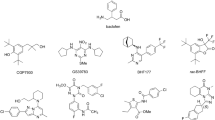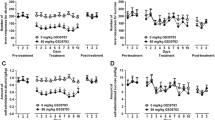Abstract
The present paper describes the results of recent preclinical and clinical studies conducted in this laboratory in order to characterize the anti-alcohol properties of the GABAB receptor agonist, baclofen. At a preclinical level, the repeated administration of non-sedative doses of baclofen dose-dependently suppressed the acquisition and maintenance of alcohol drinking behavior in selectively bred Sardinian alcohol-preferring (sP) rats tested under the homecage, 2-bottle “alcohol vs water” choice regimen. Acute injection of baclofen completely blocked the temporary increase in voluntary alcohol intake occurring after a period of alcohol abstinence (the so-called alcohol deprivation effect, which models alcohol relapses in human alcoholics). Acute treatment with baclofen also dose-dependently suppressed extinction responding for alcohol (an index of motivation to consume alcohol) in sP rats trained to lever-press for oral alcohol self-administration. Taken together, these results suggest the involvement of the GABAB receptor in the neural substrate mediating alcohol intake and alcohol motivational properties in an animal model of excessive alcohol consumption. Further, acutely administered baclofen dose-dependently reduced the severity of alcohol withdrawal signs in Wistar rats made physically dependent upon alcohol.
Preliminary clinical surveys suggest that the antialcohol properties of baclofen observed in rats may generalize to human alcoholics. Indeed, a doubleblind survey demonstrated that repeated daily treatment with baclofen was associated, when compared to placebo, with a higher percentage of subjects totally abstinent from alcohol and a higher number of days of total abstinence. Treatment with baclofen also suppressed the number of daily drinks and decreased the obsessive and compulsive components of alcohol craving. Finally, a single non-sedative dose of baclofen resulted in the rapid disappearance of alcohol withdrawal symptomatology, including delirium tremens, in alcohol-dependent patients. In both clinical studies, baclofen was well tolerated with minimal side effects. These results suggest that baclofen may represent a potentially effective medication in the treatment of alcohol-dependent patients.
Similar content being viewed by others
References
Addolorato G, F Caputo, E Capristo, M Domenicali, M Bernardi, L Janiri, R Agabio, G Colombo, GL Gessa and G Gasbarrini (2002a) Baclofen efficacy in reducing alcohol craving and intake — a preliminary double-blind randomised controlled study.Alcohol Alcohol. 37, 504–508.
Addolorato G, F Caputo, E Capristo, L Janiri, M Bernardi, R Agabio, G Colombo, GL Gessa and G Gasbarrini (2002b) Rapid suppression of alcohol withdrawal syndrome by baclofen.Am. J. Med. 112, 226–229.
Addolorato G, L Leggio, L Abenavoli, G DeLorenzi, A Parente, F Caputo, L Janiri, E Capristo, GL Rapaccini and G Gasbarrini (2003) Suppression of alcohol delirium tremens by baclofen administration: a case report.Clin. Neuropharmacol. 26, 258–262.
Agabio R, G Cortis, F Fadda, GL Gessa, C Lobina, R Reali and G Colombo (1996) Circadian drinking pattern of Sardinian alcohol-preferring rats.Alcohol Alcohol. 31, 385–388.
Agabio R, MAM Carai C Lobina, M Pani, R Reali, G Vacca, GL Gessa and G Colombo (2000) Development of short-lasting alcohol deprivation effect (ADE) in Sardinian alcohol-preferring rats.Alcohol 21, 59–62.
American Psychiatric Association (1994) Diagnostic and Statistical Manual of Mental Disorders, 4th Ed. (American Psychiatric Association, Washington, DC, USA).
Anstrom KK, HC Cromwell, T Markowski and DJ Woodward (2003) Effect of baclofen on alcohol and sucrose self-administration in rats.Alcohol. Clin. Exp. Res. 27, 900–908.
Anton RF, DH Moak and P Latham (1995) The Obsessive Compulsive Drinking Scale: a self-rated instrument for the quantification of thoughts about alcohol and drinking behavior.Alcohol. Clin. Exp. Res. 19, 92–99.
Boening JA-L, OM Lesch, R Spanagel, J Wolffgramm, M Narita, D Sinclair, BJ Mason and GA Wiesbeck (2001) Pharmacological relapse prevention in alcohol dependence: from animal models to clinical trials.Alcohol. Clin. Exp. Res. 25, 127S-131S.
Bowery NG, AL Hudson and GW Price (1987) GABAA and GABAb receptor site distribution in the rat central nervous system.Neuroscience 20, 365–383.
Carai MAM, G Brunetti, C Lobina, S Serra, G Vacca, G Minardi, G Colombo and GL Gessa (2002) Proconvulsive effect of the GABAb receptor antagonist, SCH 50911, in rats undergoing ethanol withdrawal syndrome.Eur. J. Pharmacol. 445, 195–199.
Colombo G, R Agabio, C Lobina, R Reali, A Zocchi, F Fadda and GL Gessa (1995) Sardinian alcohol-preferring rats: a genetic animal model of anxiety.Physiol. Behav. 57, 1181–1185.
Colombo G, R Agabio, C Lobina, R Reali, G Vacca and GL Gessa (1998) Stimulation of locomotor activity by voluntarily consumed ethanol in Sardinian alcohol-preferring rats.Eur. J. Pharmacol. 357, 109–113.
Colombo G, R Agabio, MAM Carai, C Lobina, M Pani, R Reali, G Addolorato and GL Gessa (2000) Ability of baclofen in reducing alcohol intake and withdrawal severity: I — preclinical evidence.Alcohol. Clin. Exp. Res. 24, 58–66.
Colombo G, S Serra, G Brunetti, G Atzori, M Pani, G Vacca, G Addolorato, W Froestl, MAM Carai and GL Gessa (2002a) The GABAb receptor agonists baclofen and CGP 44532 prevent acquisition of alcohol drinking behaviour in alcohol-preferring rats.Alcohol Alcohol. 37, 499–503.
Colombo G, S Serra, G Brunetti, R Gomez, S Melis, G Vacca, MAM Carai and GL Gessa (2002b) Stimulation of voluntary ethanol intake by cannabinoid receptor agonists in ethanol-pre-ferring sP rats.Psychopharmacology (Berl.) 159, 181–187.
Colombo G, S Serra, G Brunetti, G Vacca, MAM Carai and GL Gessa (2003a) Suppression by baclofen of alcohol deprivation effect in Sardinian alcohol-preferring (sP) rats.Drug Alcohol Depend. 70, 105–108.
Colombo G, G Vacca, S Serra, G Brunetti, MAM Carai and GL Gessa (2003b) Baclofen suppresses motivation to consume alcohol in rats.Psychopharmacology (Berl.) 167, 221–224.
Cousins MS, DCS Roberts and H de Wit (2002) GABAb receptor agonists for the treatment of drug addiction: a review of recent findings.Drug Alcohol Depend. 65, 209–220.
Czachowski CL, BH Legg and KH Stansfield (2002) Effects of the GABA(B) agonist, baclofen, on ethanol- and sucrose-seeking and self-administration.Alcohol. Clin. Exp. Res. 26, 115A.
Daoust M, C Saligaut, JP Lhuintre, N Moore, JL Flipo and F Boismare (1987) GABA transmission, but not benzodiazepine receptor stimulation, modulates ethanol intake by rats.Alcohol 4, 469–472.
Di Chiara G (1995) The role of dopamine in drug abuse viewed from the perspective of its role in motivation.Drug Alcohol Depend. 38, 95–137.
Fadda P, M Scherma, A Fresu, M Collu and W Fratta (2003) Baclofen antagonizes nicotine-, cocaine-, and morphine-induced dopamine release in the nucleus accumbens of rat.Synapse 50, 1–6.
File SE, A Zharkovsky and K Gulati (1991) Effects of baclofen and nitrendipine on ethanol withdrawal responses in the rat.Neuropharmacology 30, 183–190.
Humeniuk RE, JM White and J Ong (1994) The effects of GABAb ligands on alcohol withdrawal in mice.Pharmacol. Biochem. Behav. 49, 561–566.
Janak PH and TM Gill (2003) Comparison of the effects of allo-pregnanolone with direct GABAergic agonists on ethanol self-administration with and without concurrently available sucrose.Alcohol 30, 1–7.
Kalivas PW (1993) Neurotransmitter regulation of dopamine neurons in the ventral tegmental area.Brain Res. Rev. 18, 75–113.
Krystal JH, IL Petrakis, G Mason, L Trevisan and DC D’Souza (2003) N-methyl-D-aspartate glutamate receptors and alcoholism: reward, dependence, treatment, and vulnerability.Pharmacol. Ther. 99, 79–94.
Lal H, CM Harris, D Benjamin, AC Springfield, S Bhadra and MW Emmett-Oglesby (1988) Characterization of a pentylentetrazol-like interoceptive stimulus produced by ethanol withdrawal.J. Pharm. Exp. Ther. 247, 508–518.
Majchrowicz E (1975) Induction of physical dependence upon ethanol and the associated behavioral changes in rats.Psychopharmacologia (Berl.) 43, 245–254.
McBride WJ, A-D Le and A Noronha (2002) Central nervous system mechanisms in alcohol relapse.Alcohol. Clin. Exp. Res. 26, 280–286.
Melendez RI, ZA Rodd-Henricks, EA Engleman, T-K Li, WJ McBride and JM Murphy (2002) Microdialysis of dopamine in the neucleus accumbens of alcohol-preferring (P) rats during anticipation and operant self-administration of ethanol.Alcohol. Clin. Exp. Res. 26, 318–325.
Misgeld U, M Bijak and W Jarolimek (1995) A physiological role for GABAb receptor and the effects of baclofen in the mammalian central nervous system.Prog. Neurobiol. 46, 423–462.
Perfumi M, M Santoni, R Ciccocioppo and M Massi (2002) Blockade of ?-aminobutyric acid receptors does not modify the inhibition of ethanol intake induced by Hypericum perforatum in rats.Alcohol Alcohol. 37, 540–546.
Petry NM (1997) Benzodiazepine-GABA modulation of concurrent ethanol and sucrose reinforcement in the rat.Exp. Clin. Psychopharmacol. 5, 183–194.
Samson HH, A Chappell, C Czachowski and A Sharpe (2001) Measuring ethanol-seeking behavior: the effect of using repeated extinction trials.Alcohol 24, 205–209.
Samson HH, CL Czachowski, A Chappell and B Legg (2003) Measuring the appetite strength of ethanol: use of an extinction trial procedure.Alcohol 31, 77–86.
Smith BR, J Robidoux and Z Amit (1992) GABAergic involvement in the acquisition of voluntary ethanol intake in laboratory rats.Alcohol Alcohol. 27, 227–231.
Smith BR, AEL Boyle and Z Amit (1999) The effects of GABAb agonist baclofen on the temporal and structural characteristics of ethanol intake.Alcohol 17, 231–240.
Spanagel R and F Weiss (1999) The dopamine hypothesis of reward: past and current status.Trends Neuroscience 22, 521–527.
Sullivan JT, K Sykora, J Schneiderman, CA Naranjo and EM Sellers (1989) Assessment of alcohol withdrawal: the revised Clinical Institute Withdrawal Assessment for Alcohol scale (CIWA-Ar).Br. J. Addiction 84, 1353–1357.
Tomkins DM and PJ Fletcher (1996) Evidence that GABAa but not GABAb receptor activation in the dorsal raphe nucleus modulates ethanol intake in Wistar rats.Behav. Pharmacol. 7, 85–93.
Vacca G, S Serra, G Brunetti, MAM Carai, HH Samson, GL Gessa and G Colombo (2002) Operant self-administration of ethanol in Sardinian alcohol-preferring rats.Alcohol. Clin. Exp. Res. 26, 1678–1685.
Weiss F and LJ Porrino (2002) Behavioral neurobiology of alcohol addiction: recent advances and challenges.J. Neurosci. 22, 3332–3337.
Weiss F, MT Lorang, FE Bloom and GF Koob (1993) Oral alcohol self-administration stimulates dopamine release in the rat nucleus accumbens: genetic and motivational determinants.J. Pharm. Exp. Ther. 267, 250–258.
Westerink BHC, H-F Kwint and JB deVries (1996) The pharmacology of mesolimbic dopamine neurons: a dual-probe micro-dialysis study in the ventral tegmental area and nucleus accum-bens of the rat brain.J. Neurosci. 16, 2605–2611.
Wise RA and MA Bozarth (1987) A psychomotor stimulant theory of addiction.Psychol. Rev. 94, 469–492.
Yoshida M, H Yokoo, T Tanaka, H Emoto and M Tanaka (1994) Opposite changes in the mesolimbic metabolism in the nerve terminal and cell body sites induced by locally infused in the rat.Brain Res. 636, 111–114.
Xi Z-X and EA Stein (1999) Baclofen inhibits heroin self-administration behavior and mesolimbic dopamine release.J. Pharm. Exp. Ther. 290, 1369–1374.
Author information
Authors and Affiliations
Corresponding author
Rights and permissions
About this article
Cite this article
Colombo, G., Addolorato, G., Agabio, R. et al. Role of GABAB receptor in alcohol dependence: Reducing effect of baclofen on alcohol intake and alcohol motivational properties in rats and amelioration of alcohol withdrawal syndrome and alcohol craving in human alcoholics. neurotox res 6, 403–414 (2004). https://doi.org/10.1007/BF03033315
Received:
Revised:
Issue Date:
DOI: https://doi.org/10.1007/BF03033315




